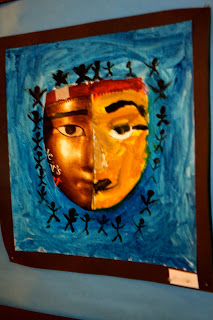In order to help kindergarten age students become better artists,
they need to understand that art is a process,
and that there are all types of art.
This lesson incorporated mixed media such as cutting construction paper,
crayons, watercolor paint and markers.

Students worked independently at their seats, but followed along to a
list of step by step instructions administered by the art teacher.
Each child was required to quietly listen for the instruction,
than react to it with specific media.
list of step by step instructions administered by the art teacher.
Each child was required to quietly listen for the instruction,
than react to it with specific media.

One instruction may say, " pick a crayon, and draw your favorite shape",
than the next instruction would be, " cut out a different shape, and glue it inside
your crayon drawing from the last step".

As the lesson continues, shapes and colors start to cross and mix with each other.






































